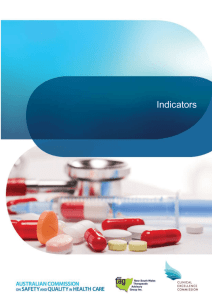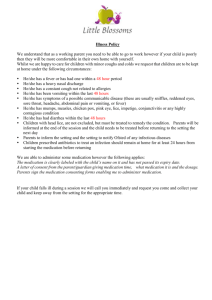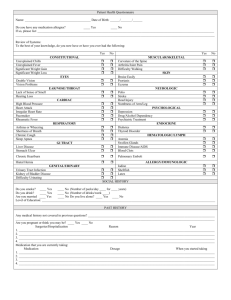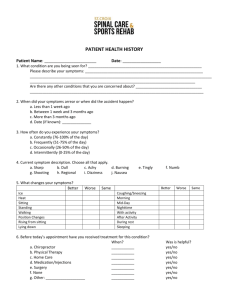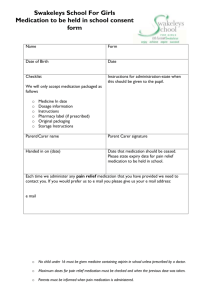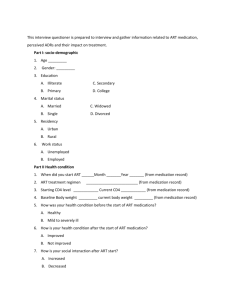WORD - Australian Commission on Safety and Quality in Health Care
advertisement
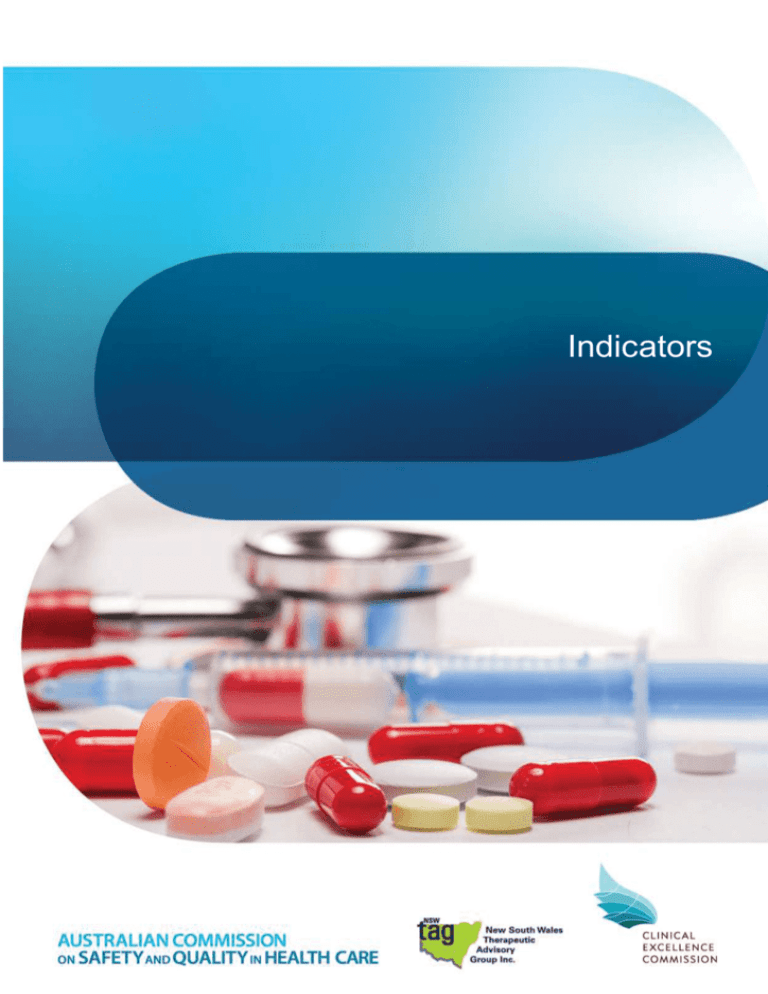
Indicators Medication ordering QUM domains: Appropriate choice Safe and effective use 3.2 Percentage of patients whose known adverse drug reactions are documented on the current medication chart Purpose This indicator addresses the effectiveness of processes to prevent further harm from known adverse drug reactions. Background and evidence An adverse drug reaction (ADR) is defined as: “a response to a medicinal product which is noxious and unintended and which occurs at doses normally used in man for the prophylaxis, diagnosis or therapy of disease or for the restoration, correction or modification of physiological function”. 1 This includes, but is not limited to, allergy and anaphylaxis to medicines. The purpose of ADR documentation is to avoid further harm to patients who have previously experienced an ADR to that (or a similar) medicine. A literature review of medication safety in Australia identified a significant gap in the communication of ADRs to patients and other healthcare professionals in the acute health care sector. 2 The Australian National Inpatient Medication Chart (NIMC) was introduced in 2006 as a strategy to improve the safe use of medicines. An audit of the NIMC in 2012 demonstrated that completion of ADR documentation occurred in 79% of the NIMCs. 3 This same study showed that, of those patients with previous documentation of an ADR, 11% were prescribed a medicine of a similar class. Another study showed that prescribing errors involving selection of a medicine to which a patient had had a previous ADR, decreased following implementation of the NIMC from 11.3% of patients to 4.6% (p=0.021). 4 Prevention of such errors depends on current and complete information being available at the time of prescribing, dispensing and administration. 5 Key definitions Known adverse drug reactions refers to any ADR identified before or during the current admission that has been recorded in the medical record. Any ADR that may influence future therapeutic decision making, whether it involves a prescription medicine (including vaccines), over-the-counter medicine or complementary medicine, should be documented. Documented means the dedicated space on the current medication chart (defined below) has been completed in a way that is consistent with instructions in the NPS MedicineWise National Inpatient Medication Chart online training course, as follows: if there are no known ADRs this should be documented on the medication chart as “nil known” if no information is known about the patient’s ADR status, for example if the patient is unable to communicat e, this should be documented as “unknown” National Quality Use of Medicines Indicators for Australian Hospitals 2014 2 where previous reactions are known, the reaction, type and date should be explicitly documented. If the reaction type or date is unknown, this should be explicitly documented. If there is not enough space to explai n the reaction type or date in full, a note should be made to refer to the patient’s medical record for more detail. The current medication chart refers to the NIMC or other chart approved for use by the hospital drug and therapeutics committee. Data collection for local use Please refer to the section Using the National Quality Use of Medicines Indicators for Australian Hospitals for guidance on sample selection, sample size, measurement frequency and other considerations. Inclusion criteria: Current adult, paediatric and neonatal inpatients. Exclusion criteria: Nil. Recommended data sources: Medication charts. The data collection tool for QUM Indicator 3.2 assists data collection and indicator calculation. Data collection for inter-hospital comparison This indicator may be suitable for inter-hospital comparison. In this case, definitions, sampling methods and guidelines for audit and reporting need to be agreed in advance in consultation with the coordinating agency. Indicator calculation Numerator = Number of patients whose known ADRs are documented on the current medication chart Denominator = Number of patients in sample Limitations and interpretation Data collection for this indicator relies on documentation of ADRs on the medication chart and in t he medical record. Good documentation supports quality patient care 6 and is a critical component of management. Poor communication can result in adverse medicine events. 7 Recording a detailed medication history at admission is a critical step in determinin g the accuracy and completeness of the list of known ADRs. This indicator does not assess the accuracy of the list of known ADRs documented in the medical record, but rather focuses on availability of complete documentation at the point of prescribing, dis pensing and administration, i.e. on the medication chart. National Quality Use of Medicines Indicators for Australian Hospitals 2014 3 Further information For more information about documentation of ADRs on the NIMC see the NIMC User Guide, available at www.safetyandquality.gov.au/our-work/medication-safety/medication-chart/support-material/ and NPS MedicineWise National Inpatient Medication Chart online training course, available at http://learn.nps.org.au Guidelines for detailed medication history taking and ADR management have been published by the Society of Hospital Pharmacists of Australia. 8 Medication Safety Self Assessment for Australian Hospitals 9 (MSSA) can help identify potential strategies for improvement with this and other indicators. The MSSA encourages development of robust systems for safe prescribing, dispensing, administration and monitoring of medicines. The MSSA is available at www.cec.health.nsw.gov.au This indicator can be used to assist hospitals in meeting the National Safety and Quality Health Service Standard 1 [items 1.2.1, 1.2.2, 1.5.2, 1.6.1, 1.6.2, 1.8.1] and Standard 4 [items 4.1.1, 4.2.1, 4.2.2, 4.4.2, 4.5.1, 4.5.2, 4.6.1, 4.7.1, 4.7.2] and Standard 6 [items 6.1.1, 6.2.1, 6.3.1]. 10 References 1. Committee of Experts on Management of Safety and Quality in Health Care (SP-SQS) Expert Group on Safe Medication Practices: Glossary of terms related to patients and medication safety. World Health Organisation, 2005. 2. Roughead EE and Semple SJ. Medication safety in acute care in Australia: where are we now? Part 1: a review of the extent and causes of medication problems 2002-2008. Aust New Zealand Health Policy 2009; 6: 18. 3. National Inpatient Medication Chart 2012 National Audit Report: Australian Commission on Safety and Quality in Health Care, 2013. 4. Coombes ID, Stowasser DA, Reid C, et al. Impact of a standard medication chart on prescribing errors: a before-and-after audit. Qual Saf Health Care 2009; 18: 478-485. 5. Building a Safer NHS for Patients: Improving Medication Safety: A Report by the Chief Pharmaceutical Officer: National Health Service, 2004. 6. The Good Clinical Documentation Guide. National Centre for Classification in Health, Commonwealth of Australia, 2003. 7. MacKinnon NJ, ed. Safe and Effective: The Eight Essential Elements of an Optimal Medication-Use System. Canadian Pharmacists Association, 2007. 8. Society of Hospital Pharmacists of Australia Committee of Speciality Practice in Clinical Pharmacy. SHPA Standards of Practice for Clinical Pharmacy Services. J Pharm Prac Res 2013; 43 (2): (suppl). 9. Medication Safety Self Assessment for Australian Hospitals: Institute for Safe Medication Practices USA (Adapted for Australian use by NSW Therapeutic Advisory Group and the Clinical Excellence Commission), 2007. 10. Australian Commission on Safety and Quality in Health Care. National Safety and Quality Health Service Standards. Sydney, ACSQHC, 2012. National Quality Use of Medicines Indicators for Australian Hospitals 2014 4
